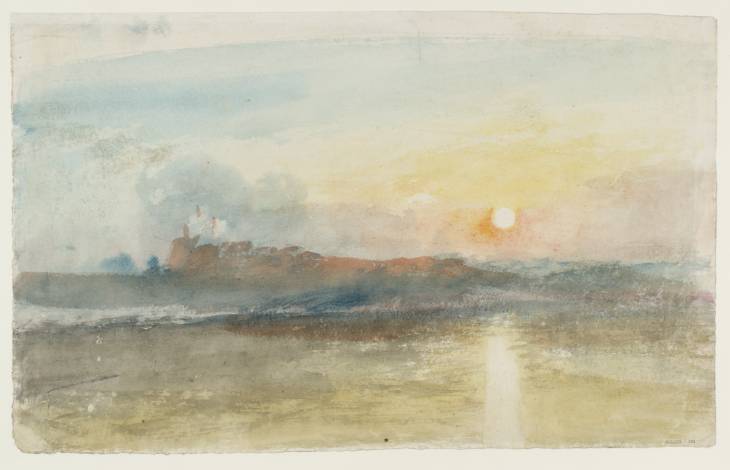Joseph Mallord William Turner ?Dunstanburgh Castle c.1828
Joseph Mallord William Turner,
?Dunstanburgh Castle
c.1828
Joseph Mallord William Turner 1775–1851
?Dunstanburgh Castle c.1828
D25313
Turner Bequest CCLXIII 191
Turner Bequest CCLXIII 191
Watercolour and gouache on white wove paper, 273 x 435 mm
Watermark ‘J Whatman | Turkey Mill | 1825’
Blind-stamped with Turner Bequest monogram towards bottom right
Stamped in black ‘CCLXIII – 191’ bottom right
Watermark ‘J Whatman | Turkey Mill | 1825’
Blind-stamped with Turner Bequest monogram towards bottom right
Stamped in black ‘CCLXIII – 191’ bottom right
Accepted by the nation as part of the Turner Bequest 1856
Exhibition history
1975
Turner in the British Museum: Drawings and Watercolours, Department of Prints and Drawings, British Museum, London, May 1975–February 1976 (103, reproduced, as ‘The sun setting over a low headland’, ?c.1825).
1982
Turner and the Sea: Watercolours from the Turner Bequest, Loaned by the British Museum, Tate Gallery, London, January–June 1982 (no catalogue, as ‘On the Coast: Sunset’).
1997
Turner’s Watercolour Explorations 1810–1842, Tate Gallery, London, February–June 1997, Southampton City Art Gallery, June–September 1997 (34, reproduced in colour, as ‘?Dunstanburgh Castle, Northumberland’, ?c.1828).
2001
William Turner: Licht und Farbe, Museum Folkwang, Essen, September 2001–January 2002, Kunsthaus Zürich, February–May 2002 (150, reproduced in colour, as ‘A Castle on a Headland ?Dunstanburgh’, ?c.1828).
References
1909
A.J. Finberg, A Complete Inventory of the Drawings of the Turner Bequest, London 1909, vol.II, p.829, CCLXIII 191, as ‘On the coast: sun setting over the land’. c.1820–30.
1975
Gerald Wilkinson, Turner’s Colour Sketches 1820–34, London 1975, p.145, reproduced in colour, as ‘Promontory and setting sun’.
1997
David Hill, ‘Turner’s “Colour Beginnings” in Britain’, Turner Society News, no.76, August 1997, p.7.
1997
Eric Shanes, Turner’s Watercolour Explorations 1810–1842, exhibition catalogue, Tate Gallery, London 1997, pp.19, 55, 96, 105 (p.55 no.34, reproduced in colour, as ‘?Dunstanburgh Castle, Northumberland’. ?c.1828, p.96 Appendix I under ‘England and Wales Series’, as ‘?Sketch for a variant view of Dunstanburgh Castle, Northumberland’. c.1828, p.105 Appendix II, as ‘Sketch: ?Dunstanburgh Castle, Northumberland’).
This colour study has been proposed by Eric Shanes as relating to the watercolour Dunstanborough Castle, Northumberland of about 1828 (Manchester Art Gallery),1 engraved in 1830 for the Picturesque Views in England and Wales (Tate impressions: T04553, T06085).2 Turner first visited the coastal ruin in 1797 and produced watercolours and paintings of it until as late as 1834, including a watercolour design of about 1806–7 for the Liber Studiorum (Tate D08118; Turner Bequest CXVI Q) under which the various versions are discussed in detail. The setting of the view to the north in the Liber design is closely comparable with the England and Wales version.
Shanes has suggested that the ‘very cursory but topographically accurate’3 approximation of the present composition to other versions may be explained by Turner’s ‘working here at speed and from memory’ to establish a general sense of the castle at dawn. David Hill has described Shanes’s identification as ‘positively wrong’,4 albeit without offering an alternative.
Gerald Wilkinson notes the ‘very wide angle of view (such as Turner often used, apparently instinctively) which contains in effect two contrasting pictures.’5
See also the introductions to the present subsection of identified subjects and the overall England and Wales ‘colour beginnings’ grouping to which this work has been assigned.
Technical notes:
As often in such compositions by Turner, the disk of the sun is reserved as blank white paper for maximum luminosity. Eric Shanes notes that the sun’s reflection ‘was achieved by the removal of colour with a sponge’, while the ‘sunlit areas of the castle are painted in gouache’.1
As often in such compositions by Turner, the disk of the sun is reserved as blank white paper for maximum luminosity. Eric Shanes notes that the sun’s reflection ‘was achieved by the removal of colour with a sponge’, while the ‘sunlit areas of the castle are painted in gouache’.1
A vertical tear from the middle of the top edge has been repaired from the verso.
Verso:
Blank
Blank
Matthew Imms
March 2013
How to cite
Matthew Imms, ‘?Dunstanburgh Castle c.1828 by Joseph Mallord William Turner’, catalogue entry, March 2013, in David Blayney Brown (ed.), J.M.W. Turner: Sketchbooks, Drawings and Watercolours, Tate Research Publication, December 2013, https://www

